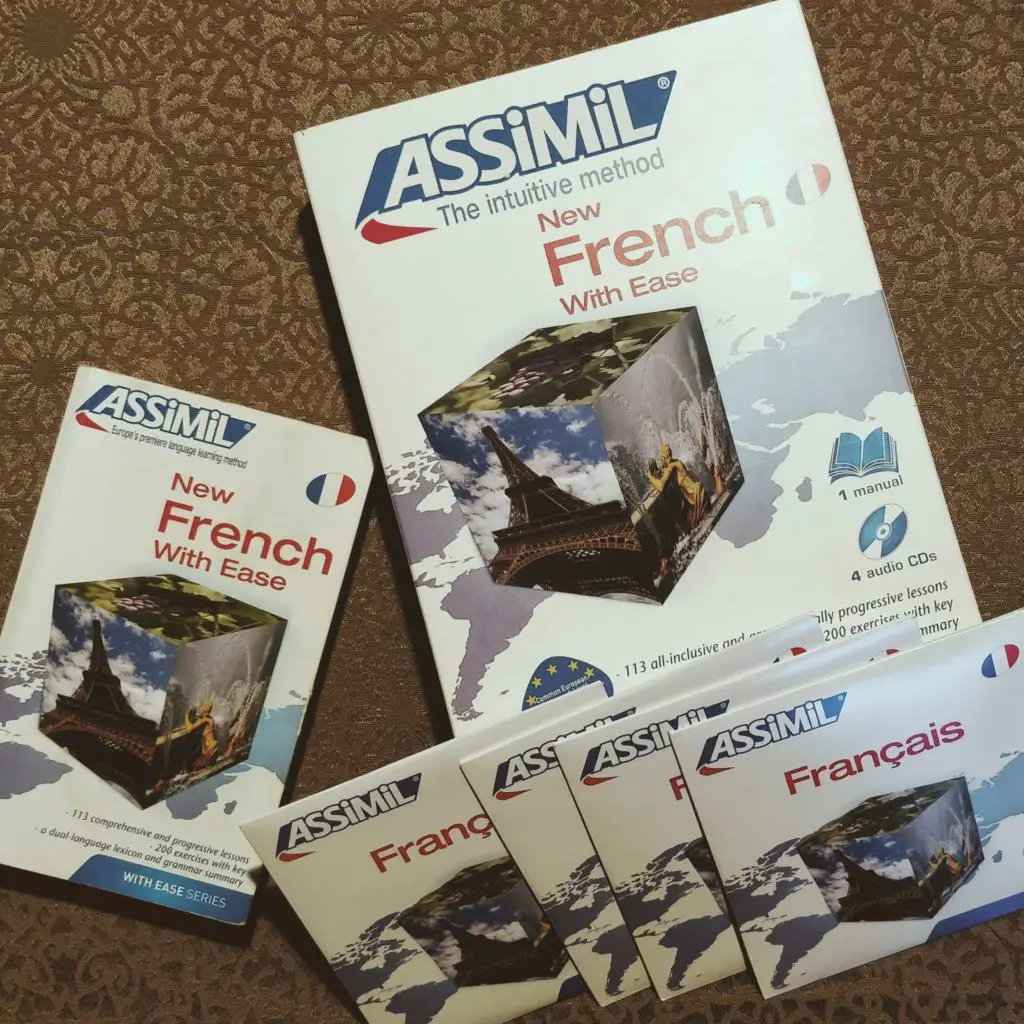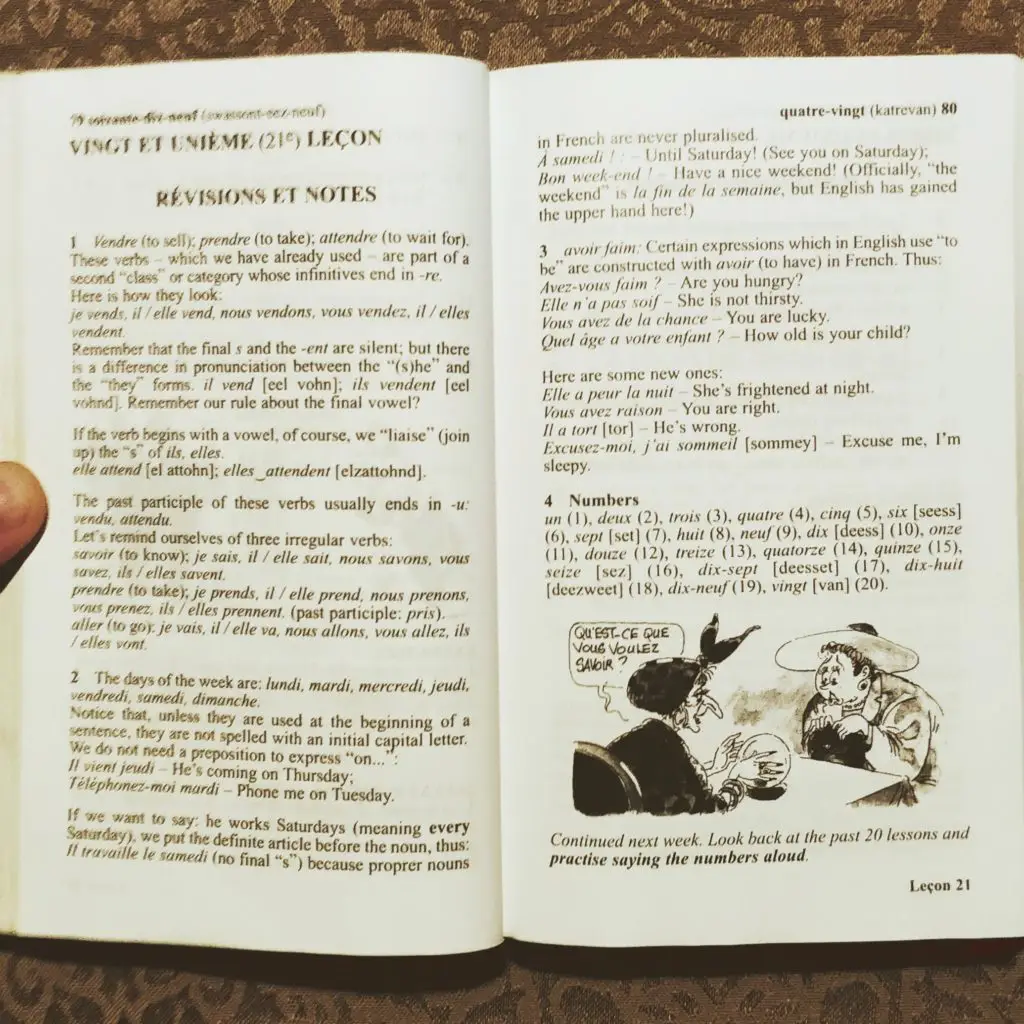My Assimil French Review and how to study with Assimil

My Assimil French with Ease box with book and cds
In this Assimil French review, I am going to go talk about the one language learning method that seriously got me started with learning French over a decade back. When you’re a beginner in a new language, or more importantly: a beginner in learning languages in general, it’s extremely important that the approach you start out with is something you fell comfortable with. You need to be able to feel that you’re getting somewhere, without being knocked out by grammar explanations, exercises and drills. For all of this, Assimil is a great fit!
If you want to read more about Assimil, you might be interested in reading my review of the Arabic edition of Assimil.
Assimil’s intuitive approach
Assimil has been around since 1929! It is, however, in no way a traditional method of teaching languages. The philosophy behind the program is that you should “acquire the language” rather than analyze and dissect it to death. Assimil describes this as intuitively learning the language like a child would. As a baby, you listen, become curious and eventually repeat. In the beginning, you mispronounce and make grammatical errors, but they’re eventually sorted out just by hearing adults speaking over and over.
But since we’re not children, we also study by reading and revising, and we can benefit from a structured course that organizes the material into gradually more complex sentences.
How the Assimil method is built up

An example of what a lesson looks like in Assimil New French with Ease
A lesson in an Assimil book is basically a short dialogue in French on one page and a translation in English on the facing page. In each lesson you’ll find notes explaining specific points. These explain concepts in the language, fixed expressions and cultural phenomena. In most language courses, you’d expect these kind of notes to be about grammar, but not with Assimil. This helps keeping studying enjoyable.
You’ll also find some exercises where you’re asked to “fill in the blanks” or translate. I generally just skim through these, because i think my time is better spent revising.

Every 7th lesson is a revision lesson with more in-depth information and also a little grammar
Every 7th lesson is a “revision lesson”. It sums up some of the points that you have studying during the previous six lessons. It’s interesting reading.
How to study with Assimil
There are several ways to work your way through an Assimil book. I have my favorite way if doing it, but something else might work better for you, so don’t be afraid to study in another way!
Generally, I like to go through the dialogues several times, focusing on different things. I try to do one lesson per day, but if you have the time, you can do more.
First I read through the dialogues in English, to know what it’s about. Then I listen to the French audio recordings one sentence at a time. I listen once, while reading the sentence in French. I then try to repeat out loud. It’s important to actually speak out loud, but you can do it in a calm voice if you prefer. At this point, I usually read the translation in English again, because I would have forgot the meaning. This is normal, don’t worry about forgetting! If there are any notes, I read these as I move forward.
Once I’ve worked my way through all of the sentences, I listen to the whole dialogue again, while following along the French text.
And that’s basically it!
Doing daily revisions
This is actually not a recommendation from Assimil, but I find that I easily forget what I have previously studied. You can do the exercises proposed by Assimil, but in my opinion, it’s much more important to revise!
So for each day when I go through a new lesson, I also go through a number of previous lessons. How many lessons you want to revise, and how you want to study them is up to you, but here’s what I do:
I read through the seven previous lessons while listening to the audio. If I’m at lesson 50, I read through lesson 42-49 while listening to the French recordings. There are a number of different ways that you could do this. The most obvious is listening while reading in French, then repeating afterwards. But you might also want to try following along in the English text while listening to the French, or perhaps to speak in the same time as you listen to the audio recordings. See my article on reading strategies in language learning for inspiration.
Revising yesterday’s lesson might be more difficult than doing one that you’ve already revised 7 times. If you find this is a problem, try going through the last 2-3 lessons like you would with a new lesson.
The passive and active phase
Assimil language learning books are known for asking you to do an “active” and a “passive” phase while going through the book.
The idea is that you should go through roughly half of the lessons “passively” and only taking in the dialogues. Then after getting to the middle of the book, you should start the “active” phase, meaning that you should go back to lesson one and try to reproduce the French text only by looking at the English sentences.
I find this quite difficult to do, if I only go through the lessons one by one without working so hard on revising every day. It is, however, a good way to get the content under your skin, and to see it a “last time” before finishing the book. So do go ahead and try and do the active phase as you move along from the middle of the book and onward. But don’t worry if you can’t produce the French from your own head yet - this takes time!
After Assimil - what now?
Like almost all language learning methods and programs, Assimil promises much more than it actually delivers. This is not a problem though, you just need to adjust your expectations. Assimil writes on the box that it takes you to a “B1” level. It doesn’t. I’d qualify it more as an introduction. A great beginners course, granted, but only warm-up. Don’t be discouraged if you can’t speak (at all!) after finishing Assimil, or if you can only passively understand very simple things in French. That’s where I were at after finishing Assimil as well.
So, to conclude this Assimil French Review, let’s talk about what I found the most difficult in learning French: Moving from the upper beginner or lower intermediate level to something more useful!
Reading texts
Since I started out studying languages, I’ve found that it’s much better to work with multiple language learning methods at once.
As you get to the second half of Assimil, I recommend that you start reading other texts. This will help you with intuitively learning about grammar, and it will quickly enlarge your vocabulary. One tool I like using for this LingQ. (Go read my review of LingQ) LingQ is a great tool to start out with when reading foreign texts in French (or in many other languages). LingQ lets you chose texts by difficulty, either from their own, rather vast library, or you might import texts that you find online. While reading you’re able to look up unknown words instantly, and the system keeps track of the status of all of these words that you’re learning.
Improve speaking and work on listening
LingQ is mostly about passively consuming text and helping you understand the written language better and better. To “activate the language” and to start speaking, I recommend a program that I recently discovered called Glossika. (And I’ve got a review of Glossika too!)
Glossika is a vast library of sentences with their recordings in English or French (or a ton of other languages). With Glossika, the focus is on listening and speaking. It helps you learn the language and “activating” it through forcing you to mimic the voice of a native speaker.
After having used Glossika and LingQ (or other reading strategies) You’ll be reading to start speaking, listening and reading in French without crutches. It’ll still be a while before you speak like a Frenchman, but you are now well on your way!
Get Assimil New French with Ease!
